


Reaction in gas phase
Nitrogen monoxide and oxygen react with each other in the gas phase. The two colorless gases, when mixed with each other, react to produce deep brown/red nitrogen dioxide:
2NO + O2 → 2NO2
This reaction is well known, but in this demonstration experiment it is shown in a spectacular way.

 The
brown nitrogen dioxide gas, produced in this experiment is very toxic and also
very corrosive. The gas reacts with humidity on the skin to produce nitric acid
and yellow stains appear on the skin when it is exposed to the gas for more than
a few seconds. Nitrogen dioxide also is insidious. The gas has a fairly strong
smell, but bad warning properties. A dangerous concentration does not produce a
strong burning sensation while it is breathed. Its effect is delayed, even up to
24 hours after exposure, there can be serious effects!
The
brown nitrogen dioxide gas, produced in this experiment is very toxic and also
very corrosive. The gas reacts with humidity on the skin to produce nitric acid
and yellow stains appear on the skin when it is exposed to the gas for more than
a few seconds. Nitrogen dioxide also is insidious. The gas has a fairly strong
smell, but bad warning properties. A dangerous concentration does not produce a
strong burning sensation while it is breathed. Its effect is delayed, even up to
24 hours after exposure, there can be serious effects!
![]()
![]() Required
chemicals:
Required
chemicals:
-
sodium nitrite
-
dilute hydrochloric acid
-
hydrogen peroxide
-
potassium permanganate (or manganese dioxide)
![]() Required
equipment:
Required
equipment:
-
little glass plate
-
bottles, 100 ml
-
tub, filled with water
![]() Safety:
Safety:
-
 Nitrogen dioxide
is very
toxic, see comments above.
Nitrogen dioxide
is very
toxic, see comments above. -
Dilute hydrochloric acid is corrosive. Rinse well, when the acid comes in contact with the skin.
-
Sodium nitrite is toxic on ingestion and is a strong oxidizer.
![]() Disposal:
Disposal:
-
The waste can be flushed down the drain with lots of water. The waste is not particularly toxic for the environment.
![]()
Procedure for the experiment
The procedure for the experiment is very simple.
- First make some oxygen gas in a 100 ml bottle. The purity of the oxygen is not critical. If some air is mixed in, then that is not a problem. Cap the bottle with oxygen and set it aside.
- Next, make some nitrogen monoxide gas and put that in a 100 ml bottle, with a small glass plate, covering the opening of the bottle. With this gas it is very important that no air enters the bottle and mixes with the gas. If that happens, then consider the experiment as spoiled.
- Finally, uncap the bottle of oxygen and quickly put this upside down on the bottle with nitrogen monoxide gas.
The final result of this procedure is the following setup:
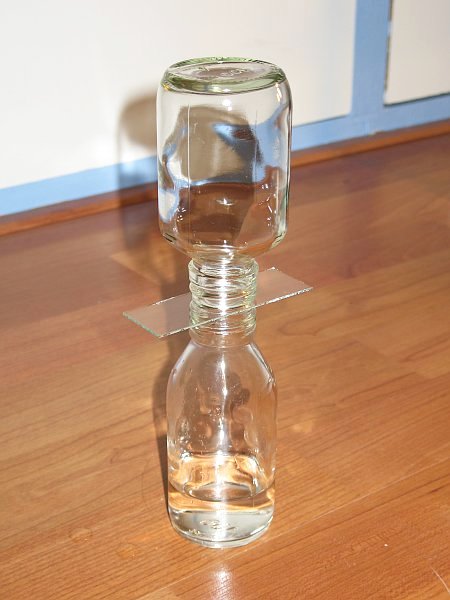
The lower bottle contains the nitrogen monoxide, the upper bottle contains the oxygen (probably mixed with a small amount of air, which is not a problem). The experiment is started by pulling away the glass plate, such that gas can be exchanged between the bottles.
The two sections below describe how the two gases can be prepared. Preparation of the gases is easy, the only trickery is the manipulation of the gasses, assuring that no air comes into the bottles.
![]()
Production of oxygen gas
![]() Oxygen
gas is made from 3% hydrogen peroxide. Take 15 ml and put this in a bottle of
100 ml and add a small amount of potassium permanganate or manganese dioxide.
Oxygen
gas is made from 3% hydrogen peroxide. Take 15 ml and put this in a bottle of
100 ml and add a small amount of potassium permanganate or manganese dioxide.
![]() When
bubbling ceases, then take another clean bottle of 100 ml and in a tub, totally
under water bubble the oxygen into that clean bottle. This step is
necessary, because the bottle in which the oxygen is produced becomes dirty with
brown stains (these can be removed simply by adding a little acid and a little
more hydrogen peroxide).
When
bubbling ceases, then take another clean bottle of 100 ml and in a tub, totally
under water bubble the oxygen into that clean bottle. This step is
necessary, because the bottle in which the oxygen is produced becomes dirty with
brown stains (these can be removed simply by adding a little acid and a little
more hydrogen peroxide).
![]() Cap the bottle with 100 ml of oxygen gas. If any water is
still in the bottle, then carefully let this run out of the bottle, without
loosing too much oxygen gas. This can be done by opening the cap, letting the
water run out and air bubble in, and if all water is gone, then quickly recap the bottle.
A little loss of oxygen is not a problem though.
Cap the bottle with 100 ml of oxygen gas. If any water is
still in the bottle, then carefully let this run out of the bottle, without
loosing too much oxygen gas. This can be done by opening the cap, letting the
water run out and air bubble in, and if all water is gone, then quickly recap the bottle.
A little loss of oxygen is not a problem though.
![]()
Production of nitrogen monoxide gas
![]() Making
nitrogen monoxide also is quite easy. Take a bottle of 250 ml and put 2 grams of
sodium nitrite in this bottle. Then pour 20 ml of dilute (10%) hydrochloric acid
into the bottle. This results in formation of a lot of brown gas mix, being NO
and NO2. The acid itself becomes blue, due to formation of N2O3,
which dissolves in the acid. If formation of gas ceases, then quickly loosely cap the
bottle.
Making
nitrogen monoxide also is quite easy. Take a bottle of 250 ml and put 2 grams of
sodium nitrite in this bottle. Then pour 20 ml of dilute (10%) hydrochloric acid
into the bottle. This results in formation of a lot of brown gas mix, being NO
and NO2. The acid itself becomes blue, due to formation of N2O3,
which dissolves in the acid. If formation of gas ceases, then quickly loosely cap the
bottle.
![]() Fill a
tub with water and take a 100 ml bottle and also fill this with water. Immerse
the bottle in the water, upside down, and do the same with the bottle, filled
with the NO/NO2 mix.
Fill a
tub with water and take a 100 ml bottle and also fill this with water. Immerse
the bottle in the water, upside down, and do the same with the bottle, filled
with the NO/NO2 mix.
![]() Bubble the brown gas mix into the 100 ml bottle. The
brown gas quickly turns colorless, especially when shaken with some water, and
at the same time, the volume decreases. Do not uncap the bottle above the water,
there will be underpressure in it and one should avoid sucking in of air. If
there is insufficient colorless gas in the bottle, then bubble in more of the
brown gas mix (which in the meantime also may have become colorless, due to the
water, which goes into the 250 ml bottle as well). Always keep both bottles
under water, upside down! Finally, take out the tightly capped bottle of 100 ml,
shake a little in order to remove the last traces of brown gas, and then uncap
again under water.
Bubble the brown gas mix into the 100 ml bottle. The
brown gas quickly turns colorless, especially when shaken with some water, and
at the same time, the volume decreases. Do not uncap the bottle above the water,
there will be underpressure in it and one should avoid sucking in of air. If
there is insufficient colorless gas in the bottle, then bubble in more of the
brown gas mix (which in the meantime also may have become colorless, due to the
water, which goes into the 250 ml bottle as well). Always keep both bottles
under water, upside down! Finally, take out the tightly capped bottle of 100 ml,
shake a little in order to remove the last traces of brown gas, and then uncap
again under water.
![]() Cover the opening of the small bottle of 100 ml with a little glass plate, while
it is still under water and then put it aside, with the glass plate covering its
opening.
Cover the opening of the small bottle of 100 ml with a little glass plate, while
it is still under water and then put it aside, with the glass plate covering its
opening.
![]()
Performing the experiment
Performing the experiment is very simple. Pull away the glass plate, while keeping the bottles in place. As soon as this is done, the denser oxygen gas moves downwards and the lighter nitrogen monoxide moves upwards. This is quite spectacular.
The pictures below show what happens, each picture is approximately 1 second after the other picture. The picture at the left is just before the glass plate is removed.
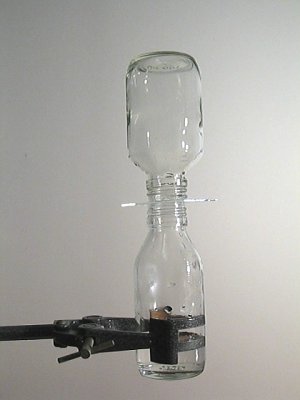
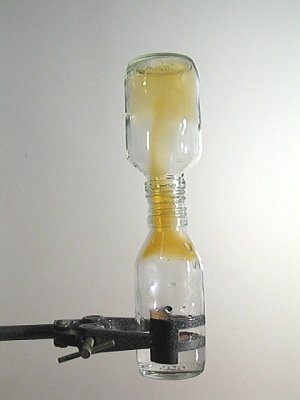
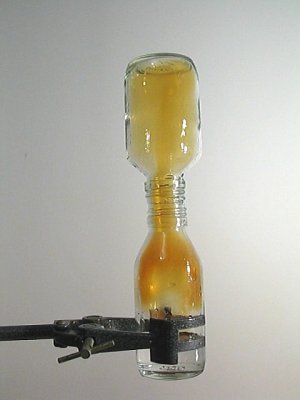
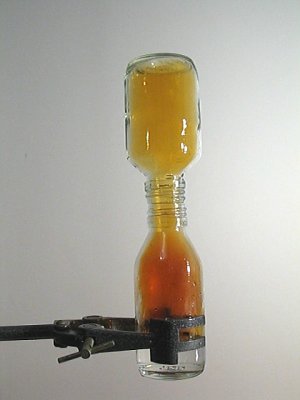
When the experiment has been running for a while, then air is sucked into the bottles. This can be explained, because the total pressure of the reaction product is at most ⅔ of the initial pressure. Three molecules of gas produce only two molecules of gas.
Two videos of this experiment can be downloaded here:
- real time video, download size is approximately 2.3 MByte
- slow motion video (7.5 times slower), download size is appr. 600 KByte.
After a minute or so, the color of the gas mix has become less intense. This is due to the water, present in the bottles. The brown NO2 reacts with water, as explained below in the discussion of results.
![]()
Discussion of results
![]() Oxygen and nitrogen monoxide both are colorless gases and they react with each
other, giving brown nitrogen dioxide:
Oxygen and nitrogen monoxide both are colorless gases and they react with each
other, giving brown nitrogen dioxide:
2NO + O2 → 2NO2
During the reaction, underpressure is built up in the bottles. This can be explained, because from three molecules of gas only two molecules of reaction product are formed. Further decrease of pressure occurs, due to the following equilibrium in which the number of product molecules even decreases further:
2NO2 ↔ 2N2O4
![]() The brown nitrogen dioxide reacts with water as follows, explaining why the
color fades and also why in the preparation of the colorless NO, one could start
with the brown NO/NO2 mix.
The brown nitrogen dioxide reacts with water as follows, explaining why the
color fades and also why in the preparation of the colorless NO, one could start
with the brown NO/NO2 mix.
3NO2 + H2O → 2HNO3 + NO
The decrease of volume, when the brown gas mix dissolves also can be explained by this reaction equation. Three molecules of NO2 only give one molecule of NO. The HNO3 dissolves in the water.
The real reaction mechanism is quite involved, the equation, given above, is a net equation.
![]() The brown NO/NO2 mix is made from solid
sodium nitrite and dilute acid. When the acid is added to the solid, then the
solid dissolves and immediately forms nitrous acid.
The brown NO/NO2 mix is made from solid
sodium nitrite and dilute acid. When the acid is added to the solid, then the
solid dissolves and immediately forms nitrous acid.
NaNO2 + H+ → HNO2 + Na+
The nitrous acid is in equilibrium with blue N2O3. The blue color of the N2O3 is clearly visible in the experiment. This N2O3 in turn decomposes.
2HNO2 ↔ N2O3 + H2O
N2O3 ↔ NO2 + NO
Part of the NO2 reacts with water, giving acid again and more NO (see equation above). So, when sodium nitrite is acidified, then the net result is formation of a mix of mostly NO with some NO2 in it as well.